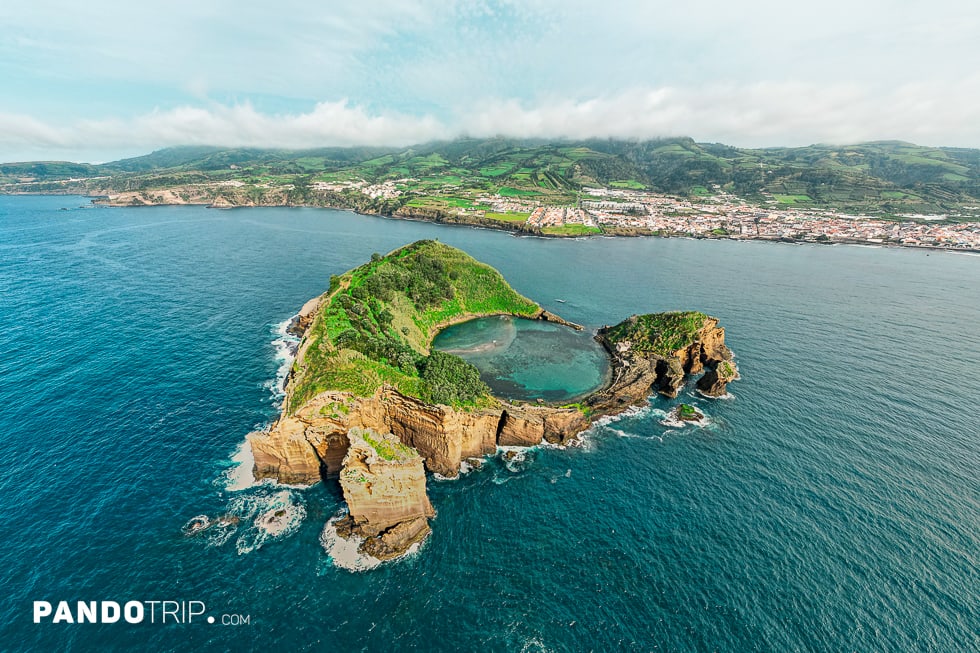Portugal captivates travelers with its dramatic Atlantic coastlines, vibrant cities, quaint villages, and endless opportunities for cultural immersion, outdoor adventure, and culinary indulgence. As more people discover Portugal’s charms, its tourism continues rising dramatically. While this confirms Portugal as an emerging jewel of Europe, increased popularity brings greater crowds to famous sights and infrastructure struggling to accommodate the masses.
We set out to create an honest insider’s guide highlighting the top 25 destinations across Portugal while keeping expectations realistic. When brainstorming our list, we first compiled all the iconic staples along with hidden gems only insiders might know. Then, we held an open discussion sharing candid impressions from our editorial team’s collective travel experiences in Portugal. Beyond raving about beautiful sunsets and dazzling sights, we also aired frustrations over finding crowded conditions, accessibility challenges, weather dependence, and other practical limitations.
Ultimately, we aimed to portray the most spectacular, culturally significant, and quintessentially Portuguese places spanning the country’s diverse offering. However, we balance the allure with transparent insight into each destination’s realities on the ground. While some spots rightfully earn reputations as Europe’s most beautiful, accessing that beauty, especially in peak seasons, requires navigating downsides from large numbers of tourists to limited infrastructure. By setting proper expectations, we hope travelers can better plan successful trips fully appreciating Portugal’s many wonders while avoiding common pitfalls.
If you’re seeking only picture-perfect sights, Portugal awaits to delight. But for those wanting the complete travel experience – beauty, wonder, frustration and revelation – then read on for an unvarnished insider’s guide to savoring this captivating country at its vivid best.
1. Sete Cidades, São Miguel Island, Azores

The volcanic crater lakes of Sete Cidades on São Miguel Island have become one of the Azores’ most iconic and photographed natural landmarks. Comprised of two interconnected lakes – one appearing blue, the other green – Sete Cidades offers travelers picture-perfect vistas from several overlook points.
However, the popularity of Sete Cidades means that it can get crowded, particularly at the two main lookout points – Vista do Rei and Boca do Inferno. These spots are known for their breathtaking views but can feel overrun with tourists during peak times. The hiking trails, especially the popular path encircling the crater, also tend to get busy, which can detract from the tranquil nature experience many seek here.
Another challenge is the area’s unpredictable weather. Due to the caldera location, Sete Cidades is prone to fog which can obscure views of the lakes. This means that timing your visit can be a bit of a gamble. On a clear day, the views are unparalleled, but on a foggy day, you might find the lakes completely hidden.

Despite these issues, Sete Cidades remains one of the most stunning places in Portugal. To escape the crowds, consider exploring lesser-known roads and trails around the caldera. Quieter overlook points like Miradouro das Cumeeiras and Miradouro do Cerrado das Freiras offer alternative perspectives of the landscape. Additionally, Lagoa do Canário, though smaller than the main lakes, provides a more peaceful setting and is typically less crowded. With a bit of planning and weather luck, Sete Cidades can reveal the unique and awe-inspiring beauty of the Azores.
2. The Douro Valley
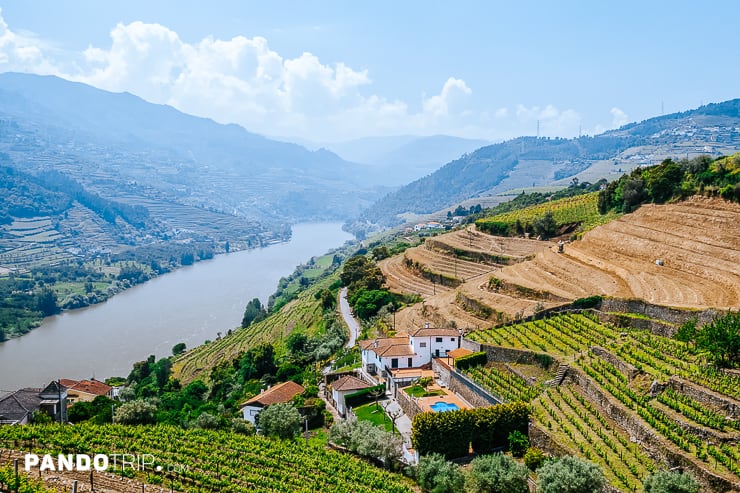
Stretching east from Porto to the Spanish border, the Douro Valley is home to one of the world’s oldest demarcated wine regions. The valley, which extends along the Douro River for about 250 km, is known for its picturesque rolling hills lined with terraced vineyards, making it one of the most beautiful wine regions on Earth.
For wine enthusiasts, the valley captivates with its iconic quintas (wine estates) dotting the hillsides along the river. Wine tours and tastings are plentiful, offering a deep dive into the region’s winemaking traditions and a chance to sample some of Portugal’s finest vintages.
The scenery along the Douro is stunning, with vineyards providing stunning photo opportunities. A boat trip along the river provides epic vineyard views, while hiking trails from riverside villages to hilltop viewpoints cater to those seeking an active exploration of the region’s slopes and gorges. Admirers of the landscape should stop at viewpoints like São Leonardo da Galafura, Casal de Loivos, and São Salvador do Mundo.
However, the popularity of the Douro Valley poses some drawbacks. It gets quite crowded, especially during the September-October grape harvest when making reservations can be difficult. The valley is also not a budget-friendly destination; expenses for wine tastings, tours, hotels, and restaurants can add up, particularly in luxury areas. To avoid inconveniences, consider visiting during the off-season – you’ll miss the harvest fervor but encounter fewer tourists and take advantage of cheaper prices on accommodations and tours.

Planning your trip also requires some forethought. Driving offers flexibility despite the winding, narrow local roads. River cruises and train routes allow epic scenery but limit accessible wineries. And you’ll need to research tours, tastings, and lodging that match your interests and budget.
In the end, the Douro Valley’s beauty and wine immersion make it well worth a visit. Travelers just need to plan around the potential inconveniences to fully savor the tastes and sights of this renowned region.
3. Cabo de San Vicente, Algarve

Portugal boasts two significant geographical points: Cabo de San Vicente and Cabo da Roca. While both are included in our top 25 list, we prefer Cabo de San Vicente for its rugged authenticity and lower visitor counts. Unlike the more heavily touristed Cabo da Roca, Cabo de San Vicente delivers a more tangible “end of the world” vibe.
Located on Portugal’s southwestern tip, Cabo de San Vicente offers panoramic cliffside views of the Atlantic Ocean. On a clear day, you can gaze out at the seemingly endless sea and understand why ancient mariners once believed this cape marked civilization’s edge. The landscape is windswept and rocky, with a lighthouse standing sentinel above the crashing waves some 75 meters (250 feet) below. Several groups of birds fly around and nest among the cliffs—it all feels pleasantly remote.
This spot is not just a geographical wonder; it’s steeped in history, being a significant site for sailors and explorers throughout the ages. The lighthouse, built in 1846, is one of the most powerful in Portugal and can be seen from 60 miles out at sea. It was the last piece of home that Portuguese sailors saw as they ventured into the unknown during the Age of Discoveries.
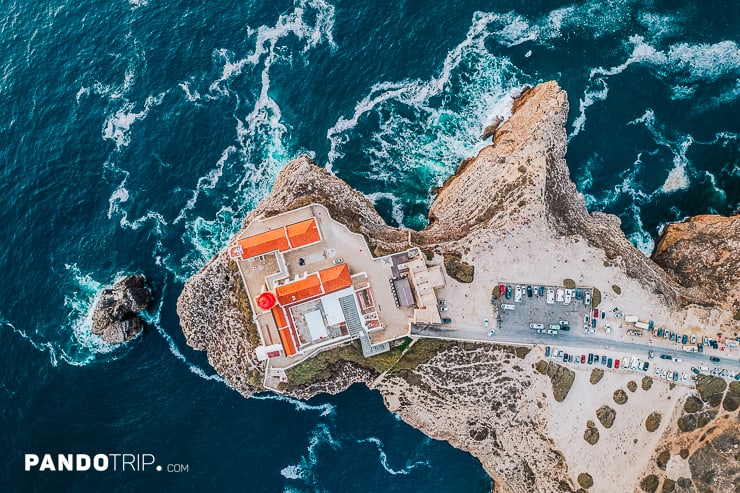
However, while it’s less crowded compared to Cabo da Roca, it still draws its fair share of visitors, especially just before sunset. The sun setting on the Atlantic Ocean not only creates a spectacular sight but also attracts crowds of people who want to enjoy it. The area’s rugged nature means it can get quite windy, which might be uncomfortable for some, but it also adds to the raw, natural experience of the place.
Yet history and scenic splendor buffs will appreciate what Cabo de San Vicente symbolizes—not just the edge of Europe but the gateway for many explorers and pilgrims journeying unknown seas. Standing atop those wind-blasted cliffs evokes a vivid sense of the mysteries and dangers those wayfarers faced sailing beyond the “end of the world” into legend and lore.
4. Cabo da Roca, Sintra

Cabo da Roca is the more popular and tourist-friendly of Portugal’s two great capes. As mainland Europe’s westernmost point, this windswept cape attracts flocks of visitors eager to stand at the edge of the continent and gaze out at the endless Atlantic Ocean.
From the parking area, a short paved walking path leads to an official monument demarcating the westernmost point of continental Europe. The cape is marked by a stone monument with an inscription from Portugal’s most famous poet, Luís de Camões, describing the area as “Where the land ends and the sea begins.”
History buffs will be pleased to know that the Cabo da Roca Lighthouse is one of the oldest lighthouses in Portugal. It started operation in 1772, escorting Portuguese maritime explorers into unknown waters. For travelers less interested in history, time will pass pleasantly watching the force of the wind and waves crashing against the 150-meter (490 ft) high cliffs.

Unlike Cabo de São Vicente, Cabo da Roca is more accessible and consequently, more crowded. Its proximity to Lisbon makes it an easy day trip for those staying in the capital. Many visitors also come from Sintra, often as part of coach tours between Sintra and Cascais. While Cabo da Roca gets crowded with bus tours, there is usually some space to spread out and enjoy the views as most tours only spend about 20 minutes here.
Of course, Cabo de São Vicente better rewards those seeking timeless coastal splendor rather than touring a human-designated “edge of Europe.” But history buffs will still appreciate glimpsing what once seemingly marked the abyss into parts unknown, before we conquered the earth’s bounds with technology and maps.
5. Vila Franca Islet, São Miguel Island, Azores

Floating just offshore from São Miguel Island, the tiny Vila Franca Islet, nicknamed the “Princess Ring” for its circular shape, perfectly blends natural beauty with outdoor adventure. The rugged volcanic rock contrasts beautifully against the azure ocean, making this a instagramable destination.
Formed by an ancient, submerged volcanic crater, the islet’s famous lagoon provides a sheltered spot for swimming and snorkeling in clear, calm waters. Venturing beyond the lagoon rewards visitors with scenic hiking trails circling the islet perimeter. While a small area is off limits, trails wrap around nearly the entire landmass. For panoramic views, head to the viewpoint overlooking the islet and village of Vila Franca do Campo beyond.
The islet also attracts thrill-seekers to its cliffs. Until 2019 Vila France was a regular stop Red Bull Cliff Diving World Championship.
Visiting this island paradise has its challenges, namely the 400 daily visitor cap. Only 200 guests can be on the islet simultaneously. Arrive early to line up for boat tickets, which sell unpredictably until the daily quota is reached. Pre-booking online helps, but limited tickets sell out fast.
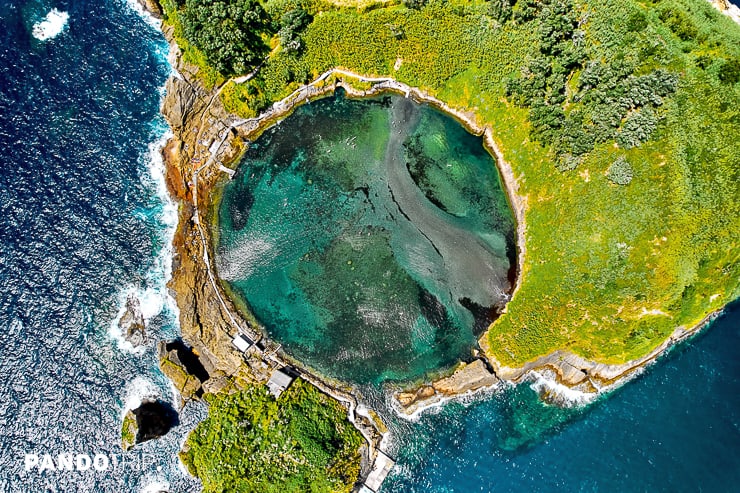
Additionally, there are no services on Vila Franca. Visitors must pack food, drinks, and anything else they may need during their stay. Have lunch on the islet, since many people arrive in the morning and leave before the midday meal when queues become quite long. With more visitors looking to depart than the boat capacity allows, waits can be frustrating.
Ultimately, striking vistas and old-world charm outweigh logistical hurdles. Proper planning is key – secure tickets early, come well-supplied, and immerse yourself in the islet’s natural splendor.
6. Peneda-Gerês National Park

Against the backdrop of granite peaks and rolling hillsides lies Portugal’s only national park, the leafy paradise of Peneda-Gerês. Despite its relatively close proximity to Porto (only a 90 minute drive), the park remains off the radar for most foreign tourists. But for those looking to venture beyond the typical tourist haunts, Peneda-Gerês offers a chance to experience unspoiled Portuguese countryside at its finest.
Outdoors enthusiasts will find plenty to occupy their time amongst the park’s lush forests and meandering streams. Weaving through sleepy villages, it sometimes feels like you stumbled onto the set of a period film, with farmers using traditional ox carts. But you’ll quickly be transported back to the 21st century when you struggle to get cell service on parts of the trails. Having offline maps on your phone is therefore highly recommended.
Tucked amongst oak, willow and alder groves are gushing waterfalls like the Cascade do Arado and Tahiti Waterfall. Deer, wolves, foxes and the famous Garrano ponies are just some of the wildlife that call Peneda-Gerês home. To take in panoramic views of the park’s vast wilderness, head to one of the viewpoints – Pedra Bela Viewpoint is perhaps the most famous, situated at an altitude of about 800 meters.

The lack of public transport makes it challenging to explore Peneda-Gerês without your own wheels. Trip planning also takes significant time and effort– choosing which trails to hike and sites to visit is no easy feat. Moreover, while it’s possible to visit on a long day trip from Porto, realistically you need more time to truly immerse yourself in the area’s natural splendor. Plan on at least 2-3 days to make the journey up to this northern region worthwhile. And be sure to download those offline maps – no one likes getting lost in a fairytale forest!
7. Pena Palace, Sintra

Pena Palace is the wildly colorful, Disney-esque castle perched on a Sintra hilltop. It’s famous for its eclectic mix of architectural styles and vividly painted exterior. Originally a monastery, it was transformed into an extravagant royal palace and summer residence during the 19th century.
Inside, the ornate rooms showcase a blend of styles as you climb up ramparts and narrow stairwells, from Arabian motifs to Gothic arches to stained glass windows. The real highlight, however, is the exterior with its panoramic views of the surrounding countryside – a view that’s hard to beat. The surrounding park, with walking paths and exotic plants, is also scenic.
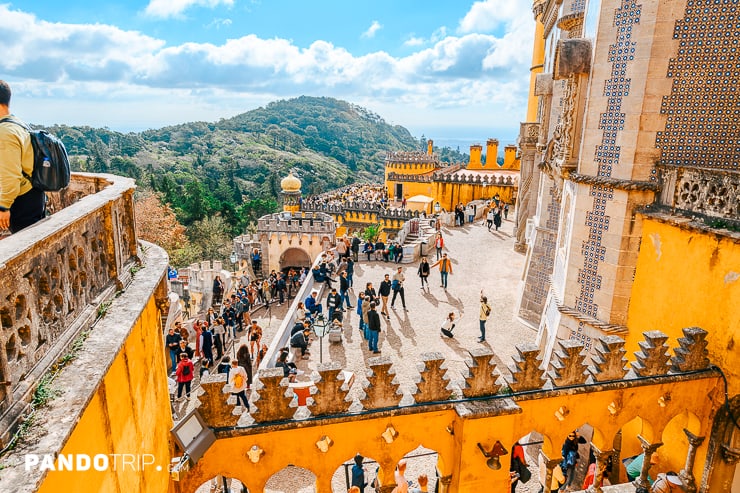
Be warned that the palace gets absolutely mobbed with tourists daily. Don’t expect a peaceful palace visit – it’s more of a sightseeing madhouse. If you go, take the Santa Maria Trail up to the entrance rather than the crowded shuttle bus. That way you can enjoy fresh air and nice Sintra views before plunging into the chaos. Allow at least half a day to properly see Pena. If skipping the interior to avoid traffic jams and long lines, it’s still worth stopping for the striking exterior facade – just aim for early or late to beat some crowds.
8. Monsanto village, Castelo Branco

Nicknamed the “Most Portuguese Village in Portugal,” Monsanto clings to a hillside in the Beira Baixa region. The stone houses seem to grow out of the boulders themselves, showcasing the village’s unique adaptation to the challenging terrain. This geological curiosity prompts many travelers to declare Monsanto one of Portugal’s most unique villages.
Monsanto lies close to the Spanish border and is not the most convenient place to reach from major cities like Porto or Lisbon. It would take over three hours to drive there, and public transport options are extremely limited.
The village is quite popular among tourists. The narrow cobblestone streets quickly fill with visitors, especially since its recent feature in the popular TV series “House of Dragons,” which has significantly boosted tourism.
Yet, the village regains its tranquility in the evenings once most of the day-trippers depart. For those wishing to extend their stay, accommodation options are limited, with just a few small hotels and holiday rentals available in the village itself. More choices can be found in nearby towns.
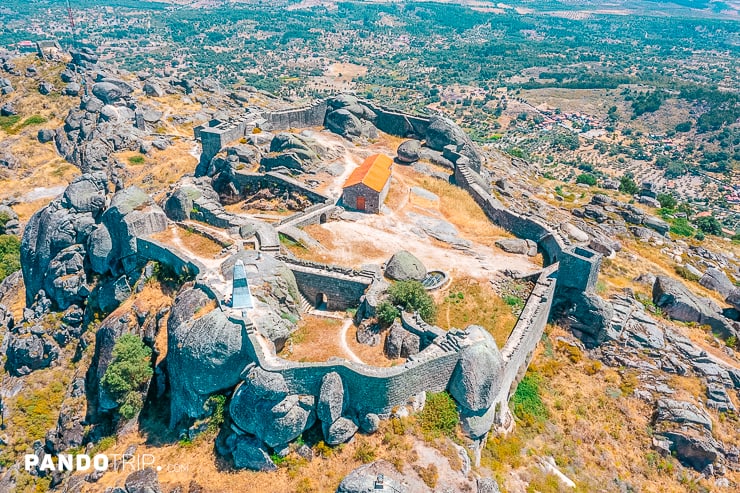
For travelers interested in photography or architecture, Monsanto is an ideal destination. Its blend of natural and human-made landscapes offers a glimpse into adaptive architecture. In terms of geologic novelty, this stone-walled oddity has few rivals across Portugal. However, aside from its photographic appeal and geological uniqueness, Monsanto might not hold prolonged interest for all travelers. Consider pairing time here with lively Idanha-a-Velha’s fado music performances or elevated history at Marialva’s medieval castle instead for a more varied travel experience.
9. Azenhas do Mar, Sintra

Nestled between the cerulean waters of the Atlantic and the rugged cliffs of the Sintra Mountains lies Azenhas do Mar, a former fishing village transformed into a summer retreat. With winding streets, generations-old homes, and cliffside trails, it offers an authentic alternative to the bustling resort towns dotting Portugal’s coast.
Azenhas do Mar emerged in the mid-20th century as an enclave for Lisbon’s wealthy families seeking refuge from the summer heat. Today most homes remain in families for generations, many with charming flower-strewn balconies overlooking the sea. The heart of the village lies in its narrow, zig-zag streets spilling down to a tiny beach where colorful fishing boats still haul in a daily catch.
Visitors can enjoy scenic views of the rocky coastline. For panoramic vistas of the village and the vast Atlantic Ocean beyond, head to the Miradouro das Azenhas do Mar lookout point. It’s the area’s most Instagrammable spot.
Azenhas do Mar boasts several popular beaches, including Praia das Azenhas do Mar, which has a tidal seawater pool replenished by the tides.
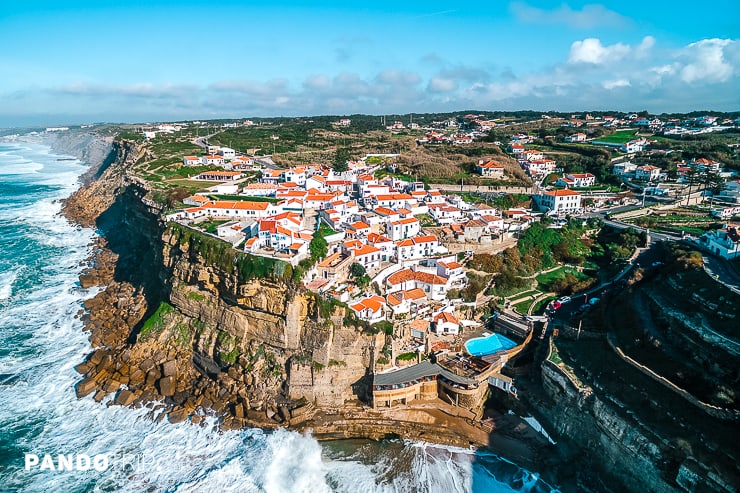
However, Azenhas do Mar transforms between seasons. In summer, the small village gets quite busy with tourists. Visit in shoulder seasons (May and September) for fewer crowds. If you’re interested in surfing, Azenhas do Mar’s winter waves create excellent conditions.
Azenhas do Mar’s convenient location near Lisbon and Sintra also makes it a great destination. It is close to other attractions on our list like Cabo da Roca and Pena Palace.
10. Ribeira District, Porto

Stretching along the Douro River, Porto’s Ribeira district is known for its colorful row houses lining the waterfront. Historically, Ribeira played a crucial role in Porto’s development, especially in trade and commerce due to its riverside location. The district’s past is reflected in its medieval architecture, alongside baroque churches. The famous Dom Luis I Bridge, a stunning double-decker metal arch bridge, connects Ribeira to Vila Nova de Gaia, known for its port wine cellars.
Ribeira district attracts hordes of tourists aiming to take in the postcard views. However, it can feel uncomfortably crowded during peak times, with selfie-snapping visitors packing the narrow cobblestone streets.
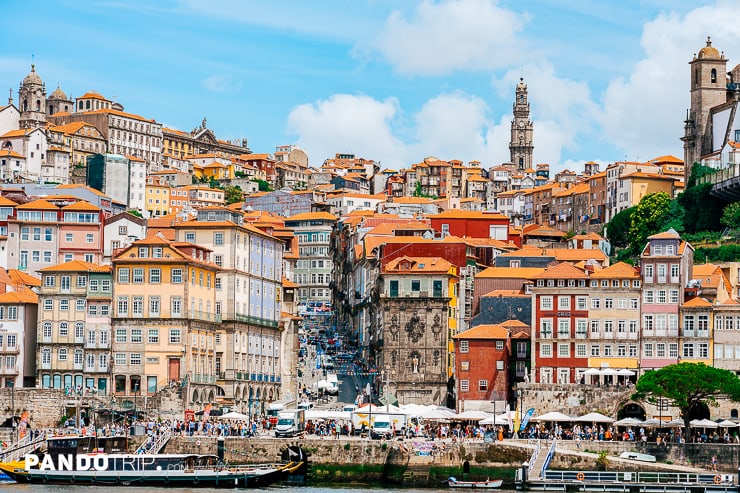
The atmosphere changes at night. While daytime brings a mix of tourists and locals, evenings draw more locals and visitors interested in experiencing Porto’s nightlife and dining. Local restaurants unfold outdoor tables, strings of lights flicker on, and Fado music floats from various bars, lending Ribeira a more romantic, charming vibe.
However, several restaurants prioritize style over substance, with inflated prices and mediocre food compared to less Instagram-friendly options elsewhere in Porto. But for the iconic waterfront scenery – albeit crowded during the day – Ribeira remains an atmospheric district to explore for a few hours. Just don’t expect an off-the-beaten-path experience.
11. Quinta da Regaleira, Sintra

The sprawling Quinta da Regaleira estate is renowned for its ornate Gothic styling and elaborate grounds filled with symbolic carvings, secret passageways, and towers offering panoramic views over Sintra. It stands out as an ostentatious relic from the wealth that poured into Sintra in the 19th and 20th centuries when it became a hill station retreat for Portuguese royalty and aristocracy.
One of the site’s most unique features is the Initiation Wells, which are inverted towers plunging into the earth used for ceremonial purposes. These wells, along with the labyrinthine grottoes that connect them, offer an almost mystical exploration experience. However, this uniqueness can be a double-edged sword. The wells and grottoes are fascinating, but they can feel claustrophobic for some, especially during busier times when the narrow passages get crowded.

For travelers primarily seeking beautiful photo opportunities, Regaleira satisfies. Architecture and garden aficionados may also appreciate studying its eccentric details. However, it’s a very popular attraction and it gets crowded, especially during peak times (10am-2pm). If queues are long, consider visiting other nearby attractions like Palácio de Monserrate or Palácio Biester instead and return later.
12. Benagil Cave, Algarve
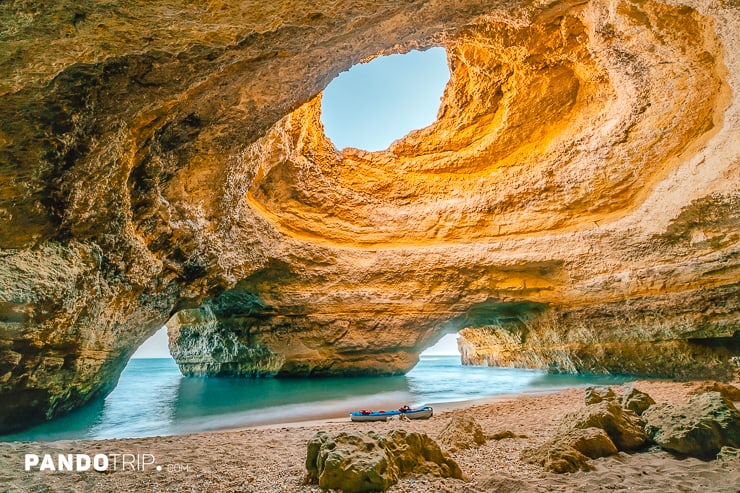
The Algarve region is famous for its limestone caves and grottos carved into the towering cliffs along the coast. Among these, the Benagil Sea Cave stands out as the most beautiful. Formed through erosion of the limestone cliffs over millions of years, it is known for the Cathedral-like hole and lighting inside.
While beautiful in photographs, especially the iconic shot directly underneath the ceiling “eye,” the reality of the crowded experience is not as serene. The number of visitors to the relatively small cave has increased exponentially in recent years, making it nearly impossible to fully appreciate its distinctive geology and natural light show. Benagil, unfortunately, has become a victim of its own popularity.
In response to its growing popularity and to ensure safety and manage environmental impacts, local authorities imposed restrictions on visitors in September 2023. The only way to currently access the cave is by boat, as access by kayak, swimming, bodyboards and stand-up paddleboards is no longer allowed. However, even boat tours don’t allow disembarking inside the cave itself. Passengers typically spend only a few minutes inside before having to leave for other boats.
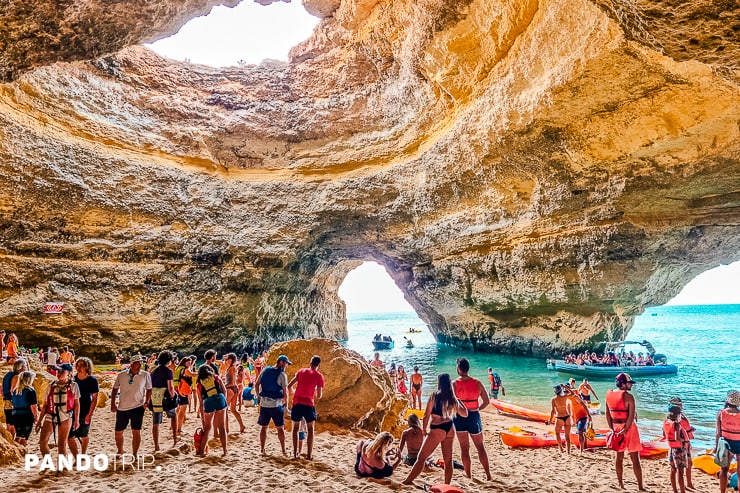
While Benagil’s spell may be broken by the bitter realities of Instagram fame, perhaps some solace lies ahead. If visitor limits are sustained, the cave may regain some of its lost serenity. For now, manage expectations before joining the queue, but the coastal scenery surrounding Benagil yet retains its wonder.
13. Covão dos Conchos, Serra da Estrela

Covão dos Conchos is an artificial lake located in the Serra da Estrela mountains of Portugal. It is most famous for its bell-mouth spillway – a large concrete funnel structure that looks like a portal to another world.
The spillway was constructed in 1955 as part of a hydroelectric dam project. Over 60 years, vegetation has grown around the structure, making it seem more natural and mystical.
The spillway and lake were relatively unknown until 2016, when viral photos exposed the “portal” to the masses. However, Covão dos Conchos remains off the beaten path compared to most tourist sites.
Reaching the lake involves an easy hike. The area also offers views of Torre Peak, the highest point in mainland Portugal. While the summit trek proves more grueling, it’s achievable for fit hikers. Visiting both sights in one day is possible for those up for the challenge.

However, it’s important to note Covão dos Conchos lies far from any big city. Getting there necessitates a true commitment to rugged hiking and appreciating nature in its rawest form. The remote locale and physical journey involved won’t appeal to everyone. But for outdoor enthusiasts intrigued by the fusion of natural splendor and human engineering, a visit could prove profoundly rewarding.
14. Nazaré village, Leiria

With its picturesque beaches and quaint seaside charm, Nazaré lures many travelers. Yet this small fishing village turned surfing mecca is famed most for its colossal winter waves that can swell over 30 meters (100 feet) high. From the iconic red lighthouse viewpoint, you can witness daredevils challenging these stunning giants.
Listed in the Guinness Book of Records for the biggest waves ever surfed, Nazaré’s waves peak during the October to March big wave season. The World Surf League holds the prestigious Tudor Nazaré Big Wave Challenge competition within this period, choosing the exact date based on optimal surf conditions. If conditions appear favorable, an alert issues 72 hours before the potential event.
Yet expectations of constant giant wave action often leave visitors disappointed if no record-breakers emerge. Outside the peak October through March storm season, Nazaré’s waves appear less monumental than advertised. And even during prime months, specific conditions like canyon depth, winds, and swell direction must perfectly align to produce the towering walls of water that attract global attention. To reliably see the famous waves, plan to stay at least two-three weeks during the prime season.

Crowding poses another issue on big winter wave days. Finding a good cliffside viewing spot can prove extremely difficult given the massive crowds, sometimes swelling to 20,000 spectators. Because of the town’s popularity, accommodation, food, and other prices also spike.
Yet there’s a reason Nazaré’s elusive giant waves still mesmerize despite their rarity. In those fleeting moments when conditions align, their sheer power and strange beauty transfix us. So it seems sensible that this once humble fishing village now stakes its livelihood on surfing’s ultimate trophy – the hundred-foot beast from the deep.
15. Livraria Lello, Porto

The Livraria Lello bookstore in Porto is often called one of the most beautiful bookstores in the world, and with good reason. Its neo-Gothic facade and opulent woodwork interiors make for striking photos frequently seen on Instagram.
Many also know Livraria Lello as the supposed inspiration for J.K. Rowling’s Hogwarts in the Harry Potter series. It’s believed Rowling visited when she lived in Porto from 1991-1993. However, in 2020, J.K. Rowling tweeted (or “xeeted” now) that she never visited Livraria Lello while living in Porto and that it has nothing to do with Hogwarts.

Nonetheless, Livraria Lello remains a huge tourist draw for Potter fans. As a result, expect dense crowds jockeying for photos, especially on the famous crimson spiral staircase. In 2015, the store implemented an entrance fee simply to manage the excessive visitors.
In truth, for those looking to simply browse books, go elsewhere; this location has sadly become overrun by its own popularity. But for travelers primarily seeking beautiful interior spaces, Livraria Lello still delivers visual splendor, albeit alongside dense tourist crowds. Just don’t expect a particularly relaxing bookstore visit.
16. Óbidos Village, Leiria

A bit more than an hour north of Lisbon rests the postcard-perfect Óbidos Village. Enclosed within a nearly intact medieval wall dotted with lookout towers and entry gates, this village transports visitors back in time with its cobbled lanes and whitewashed houses adorned with bursts of bougainvillea and azulejo tiles.
At the highest point sits Óbidos Castle, the main highlight and most iconic landmark. Guests can wander the castle grounds and enjoy panoramic views over red-tiled rooftops and rolling hills from the outer walls. The castle once served as a royal palace and today sections where the Portuguese king slept have been converted into a luxurious hotel set within the historic walls.
Wandering the quaint streets, you’ll notice shop windows proudly displaying ginja, a sweet cherry liqueur native to the region, often served in chocolate cups. If you happen to visit in the spring, you might catch Óbidos’ annual two-week Chocolate Festival held each March. Where chocolatiers from all over Portugal flock here to showcase their confections.
The surrounding region also has much to offer. Just a short drive away lies the tranquil Lagoa de Óbidos dotted with colorful fishing boats. For some beach time, head to the nearby surf town of Peniche and seaside village of Baleal, which sits on a pint-sized peninsula with gorgeous beaches on both sides. From Peniche, you can also take boat trips out to the Berlengas Islands, another place on our list.

On paper, Óbidos seems to check all the picture-perfect Portuguese village boxes. But reality is a bit different. Of course, you may feel authenticity in the early morning or late evening, but in midday when the tour buses roll in, the charm bracelet shatters and Óbidos turns into a human traffic jam. It can be quite hard to feel that authenticity due to the high number of visitors and tourist-oriented shops and activities.
Yet, there’s good reason this darling village lures Portugal’s masses. Walking the 15th-century fortified walls gazing over red roofs and rolling emerald hills never loses its magic. Just acknowledge you’re visiting a beautiful relic that artfully preserves the illusion of the past rather than a thriving present-day community before crossing through those iconic gates.
17. Berlenga Grande, Berlengas Islands

The Berlengas Islands, located about 10 kilometers off the coast from Peniche, are known for their dramatic natural beauty and abundant wildlife. Though the archipelago has several islands, only the largest—Berlenga Grande—allows visitors to step foot on its shore. To preserve its fragile ecosystem, visiting is allowed only from March through October, with a 550 daily visitor cap.
Berlenga Grande captivates with its rocky cliffs, grottos, and hidden coves surrounding small beaches. The most famous beach on the island, though tiny, is Carreiro do Mosteiro, which offers crystal clear waters. The peaceful island trails winding through Berlenga Grande give way to diverse seabird colonies in spring and summer. You can also partake in snorkeling, canoeing and other water sports.
The island’s main highlight is the 16th-century Fort of São João Baptista, constructed to defend the coast from pirate raids. Throughout its history, the fort played a vital role in multiple conflicts, including the Portuguese Restoration War and the Liberal Wars. Today the Fort of São João Baptista is one of the most scenic forts in Portugal, offering breathtaking views of the Atlantic.
Reaching Berlenga Grande requires some logistical effort. You can either take a 25-minute speedboat or opt for a more stable open-air ferry, both departing from Peniche. Due to the daily visitor cap, booking tickets well in advance is essential. Contact local tour operators, listed online, before arriving.

Overnight accommodation choices are extremely limited, with only two hotels and a camping area on the island. Peniche offers more lodging options as an alternative base. Note that you must bring all your own food and water since there is only one restaurant and one small store on Berlenga Grande. Both are not always open and prices are higher compared to the mainland.
In the end, the Berlengas offer one of Portugal’s most striking natural island settings, if you moderate expectations for amenities and secure spots early. Crowds do swell in high season but you can still find peaceful trails and coves with some effort. Just prepare for the island’s limits on visitors and resources.
18. Piódão village, Serra do Açor mountain range
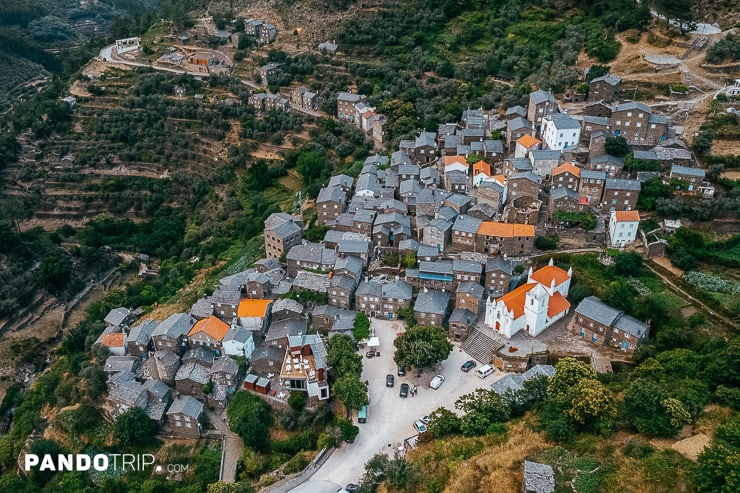
Tucked away in a remote valley of the Serra do Açor mountains, Piódão presents a striking vision unlike anywhere else in Portugal. Unlike the country’s whitewashed villages, Piódão’s dark schist stone architecture lends the village an ancient, mystical air.
Initially, we debated whether Piódão warranted inclusion among Portugal’s best destinations. Its isolated location kept it absent from the grand historical narratives of the nation. Only recently has Piódão stepped into the spotlight, mainly for its cinematically photogenic stone houses and dramatic valley setting.
Yet in the end, we felt compelled to grant this village a spot on the list. Beyond its camera-ready beauty, Piódão symbolizes the resilience and continuity of Portuguese culture, persevering largely unchanged for over seven centuries. We found Piódão so captivating that we’ve dedicated a separate in-depth feature article to fully relate its remarkable story.

Wandering the narrow lanes, one cannot help but be awed contemplating generations of villagers who carved out lives amid these same schist walls and granite footsteps. Though isolated, forgotten by time and untouched by progress, Piódão endured through faith, fortitude and communal bonds.
Reaching Piódão requires effort, given its tucked-away location. You’ll need a car to traverse the winding mountain roads. The remote setting means it’s not ideal for those seeking a quick, convenient side trip. However, for travelers keen to venture off the beaten track, Piódão offers an authentic glimpse into Portugal’s past. Beyond the Instagram-famous views, Piódão is an exceptionally well-preserved schist village, which represents remarkable historical continuity and the resilience of traditional ways of life.
19. Miradouro da Senhora do Monte, Lisbon
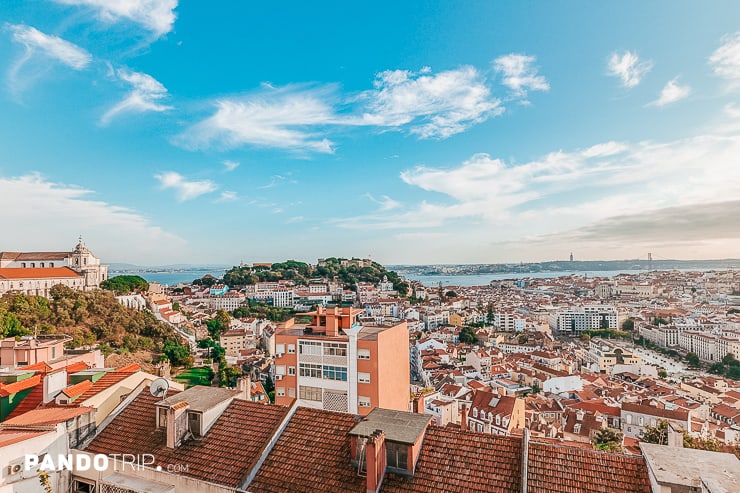
Lisbon is known as the city of seven hills, offering no shortage of stunning vistas from various viewpoints (or miradouros). Each offers a unique perspective of this vibrant city, and choosing the ‘best’ is often a matter of personal taste. Miradouro da Senhora do Monte was once a peaceful, almost secret, spot for young couples, but has gained popularity in recent years, while still being less crowded than other viewpoints like Miradouro de Santa Luzia, Miradouro da Graça, and Castelo de São Jorge.
Perched atop one of Lisbon’s highest hills, Miradouro da Senhora do Monte offers what is perhaps the most panoramic viewpoint in the city. On a clear day, you can see across the cityscape, from the São Jorge Castle to the Tagus River, and even catch a glimpse of the distant Arrábida Mountains.
Access to this viewpoint is relatively straightforward. The iconic Tram 28, a classic Lisbon experience in itself, has a stop nearby. From there, it’s a manageable 5-10 minute climb. However, be prepared for potentially crowded tram rides, especially during peak hours, so consider walking instead.

The main drawback here, as with many popular sites in Lisbon, is the influx of tourists. The constant buzz of tuk-tuks and chatter of visitors can detract from the tranquility of the experience. For a more relaxed visit, consider descending later at night when busloads thin out and city lights glitter the vista. While Miradouro da Senhora do Monte may no longer be the quiet retreat it once was, its expansive views still make it a compelling spot for anyone looking to capture the essence of Lisbon from above.
20. Braga, North Portugal

Unlike the flashy hotspots of Lisbon and Porto, Braga offers a more low-key yet history-steeped visit. Known as the religious heartland of Portugal, Braga’s main claim to fame is the elaborate Bom Jesus do Monte pilgrimage site. Its renowned Baroque stairway consists of 577 steps with 17 landings decorated with fountains and statues. At the top, the neoclassical church was built by Carlos Amarante, featuring an Italian-inspired design that integrates harmoniously with the northern Portuguese landscape. It’s quite a sight even for non-religious visitors.
In addition to the Bom Jesus do Monte, Braga has other cultural and historical experiences to offer. The Sé de Braga cathedral and various churches, squares and mansions provide a dose of culture around town. For sightseers, there’s the massive Praça da República main square and scenic gardens like the Jardim de Santa Bárbara to relax in. Shoppers will appreciate the shopping streets filled with stores selling everything from traditional Portuguese handicrafts to global fashion brands.
Football fans may view the Estádio Municipal de Braga stadium as a modern-day temple. Designed by Pritzker Prize-winning architect Eduardo Souto de Moura, it was inspired by ancient South American Inca bridges and carved into the Monte Castro hillside. The stadium’s canopy-style roof over each stand is supported by a structure of steel cables that cross the entire field, allowing in natural light. Estádio Municipal de Braga has received several design awards and hosts the local club S.C. Braga, packing in over 30,000 passionate fans on match days.

Unlike the immediacy of Lisbon and Porto, Braga has a quieter yet equally rich offering of cultural and historical experiences. This contrast can be both a pro and a con for visitors. Those seeking an authentic alternative to Portugal’s larger cities will find Braga refreshing. However, some accustomed to the faster pace may need more patience to fully appreciate Braga’s unique appeal.
21. Ponta da Piedade, Algarve
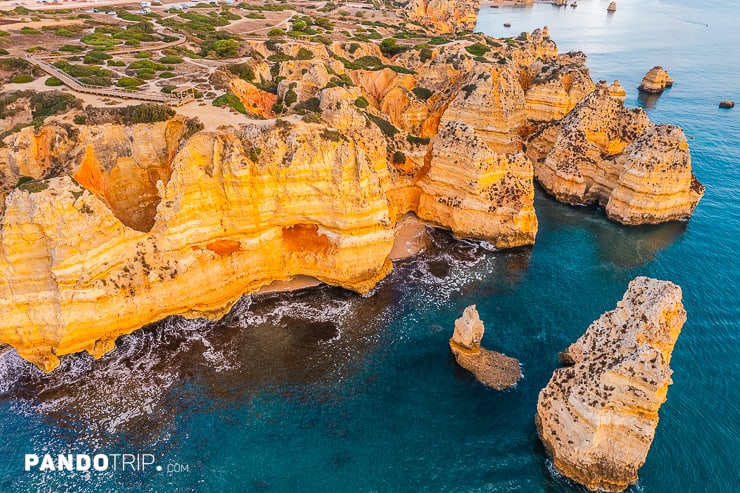
Tucked along the coastline of Lagos in the Algarve region, Ponta da Piedade is one of Portugal’s most scenic and photographed natural landmarks. The area is known for its dramatic sandstone cliffs, sea arches, grottos, and rock formations that jut out into the Atlantic Ocean. Visitors can explore it all by land via a network of trails and viewpoints, or by sea with boat tours that cruise along the coastline.
It’s easy to see why tourists get drawn in by images of the magnificent cliffs and rock formations at Ponta da Piedade. The dramatic seaside landscape does make for some of the most stunning coastal views in Portugal. Yet some visitors come away feeling let down after witnessing the destination’s popularity firsthand.
When seeing those flawless photos, one imagines having peaceful alone time to contemplate the crashing waves against the iconic stone arch or getting lost deep in thought while exploring the sea caves at Praia do Camilo. The reality ends up much different once the crowds descend. Hordes of tourists jostle on the cliffside trails and viewpoints, making it nearly impossible to appreciate the scenery without disruption. Boat tours require standing in long queues for hours before departure. And while tours do provide access to admire the famed Lagos grottoes, you’ll share cramped spaces with dozens of other passengers.
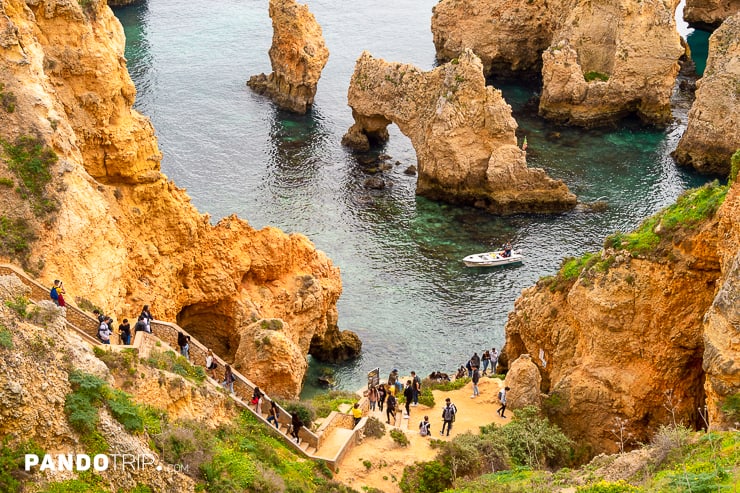
The best way to avoid the crowds is to visit early in the morning, book tours well in advance, or seek out the more isolated beaches and trails. Even popular hiking trails like the Seven Hanging Valleys Trail can be less crowded, especially the sections further from the main attractions and parking areas.
The natural beauty of Ponta da Piedade certainly lives up to the hype. But the constant crowds diminish any hopes for serene introspection amid the grottos and coastal formations. Unless waking at dawn or lingering until sunset, visitors will be unlikely to find solitary respite. While Ponta da Piedade sells the dream through gorgeous images, dealing with the overwhelming tourist crowds remains the frustrating trade-off.
22. The University of Coimbra, Coimbra
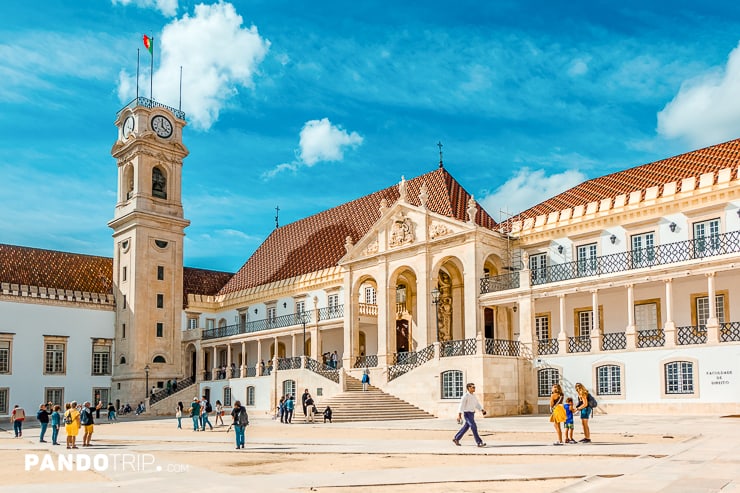
The University of Coimbra is Portugal’s oldest university and one of the oldest in Europe, having been established in 1290. It rose to fame in the 16th century under the stewardship of King John III, who invited prominent scholars from across Europe to expand the range of subjects taught and transform the school into one of the most respected centers of learning at the time.
Today, the university remains a popular tourist destination primarily for its extravagant Baroque library, known as the Biblioteca Joanina. It’s one of the most beautiful libraries in Europe, decorated with elaborate gold tooling along its floors, ceilings, and bookshelves. The library was built in the early 18th century to house the university’s expanding rare book collection. While visually striking, visitors should be aware that photography is prohibited inside due to the delicate nature of the books. That could be a bummer for Instagrammers.

Beyond the library, the University of Coimbra’s various old colleges and administrative buildings display a unique aesthetic melding of architecture from the Middle Ages onward. Wandering through arched hallways and stone courtyards lined with tiles indigenous to Coimbra, one can’t help but feel immersed in Portuguese academic history. That said, certain sections of campus are off limits to tourists which can hamper one’s exploration.
For those interested in Portugal’s scholarly past, the University of Coimbra offers an unparalleled look into a centuries-old place of learning. Just don’t expect an expansively open or tranquil experience given the popularity of the library and the continued functioning of school facilities.
23. Praia da Marinha, Algarve

With its golden cliffs plunging into azure waters and pocket-sized coves, Praia da Marinha represents a quintessential Portuguese beach paradise. Located in the Algarve region, this southern coast beach looks as though it was torn from the pages of a travel magazine.
Considered one of the most beautiful beaches in Europe, Praia da Marinha lives up to the hype with its postcard-perfect scenery. However, with popularity comes crowds that can overwhelm its petite sandy stretches during summer. Once navigating the long stairway descent to beach level, you’ll likely scramble to stake out one of the few spots not already claimed by sprawling towel-and-umbrella camps.
Accessibility presents challenges for visitors. While there is a bus service, it runs infrequently. Driving remains the easiest transportation option, but the small 32-space car park fills quickly. Once full, police close the only access road to prevent illegal parking.

In the shoulder and cooler months, Marinha feels far removed from its chaotic high-season persona. With thinner crowds, space opens up to leisurely appreciate the scalloped coastline’s graceful contours and layers of golden rock. Just know Marinha’s stunning geology and crystalline waters come with a prime-season price – sharing the beauty with humanity en masse.
24. Umbrella Street, Águeda

Bursting with bright pops of color, Umbrella Street has transformed Águeda into one of Portugal’s quirkiest attractions. It earned its place on this list by exemplifying how creativity can transform an otherwise ordinary town into a viral sensation. What originated as a decorating idea in 2011 has become an annual tradition. Every year, the streets of Águeda are filled with thousands of colorful umbrellas hanging overhead, turning the modest roads into an iconic Instagrammable spectacle.
Visiting Águeda is only worthwhile during the installation months of July to September. The July period also coincides with the ÁgitÁgueda Art Festival, adding a vibrant layer of cultural activities and installations. The umbrellas don’t just disappear after summer. In recent years, a Christmas edition of the Umbrella Sky Project has lit up the street, with illuminated umbrellas and a red carpet transforming the space into an enchanting winter scene, perfect for those Instagram moments.
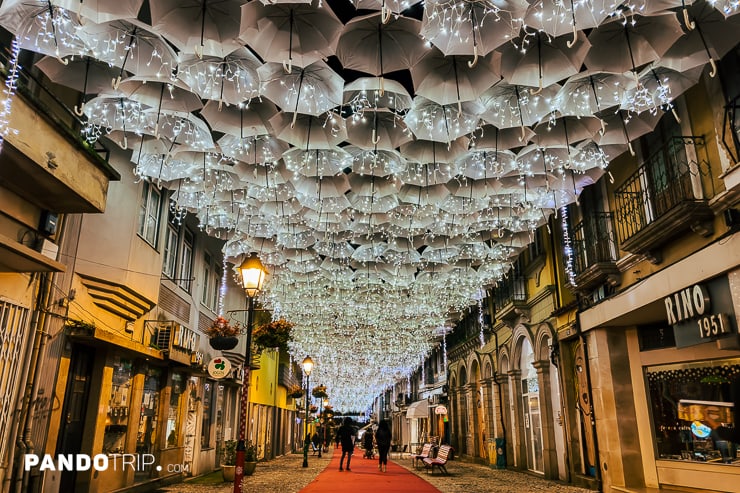
Beyond snapping selfies under the patchwork canopy, there frankly isn’t much else to do in town. Águeda is a typical Portuguese town, offering a glimpse into everyday life rather than tourist-centric attractions. The umbrellas are the main event rather than a sideshow curiosity.
Yet the umbrella art encapsulates the innovative spirit and collective effort that can emerge when residents collaborate around an inspired vision. Using inexpensive materials, the displays have inspired copycat tributes globally while drawing travelers eager to witness the community ethos underpinning this phenomenon.
25. Belém Tower, Lisbon

The Belem Tower is one of Lisbon’s most recognizable landmarks, located along the city’s waterfront. Built in the early 16th century, it originally served as a defensive fortress to protect Lisbon’s harbor. Today, it’s one of the popular tourist sites.
The main attraction is climbing up to the rooftop terrace for photos of river and the city that’s picturesque, especially at sunset. Inside there’s not much to see – some bare rooms and staircases. However, expect long lines during peak times.
The tower’s architecture has interesting Manueline style stonework decorations on the outside. The adjoining gardens and monument to the Age of Discoveries offer pleasant areas to walk around. Still, many may find the tower itself somewhat over-hyped compared to other European castle-type structures. It’s more of a historical marker than a lavish castle.

